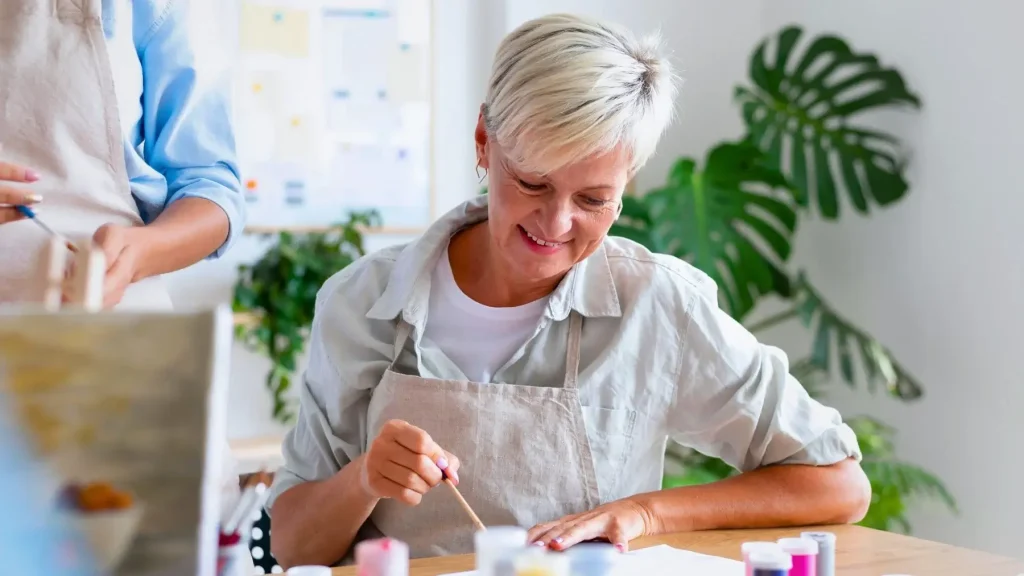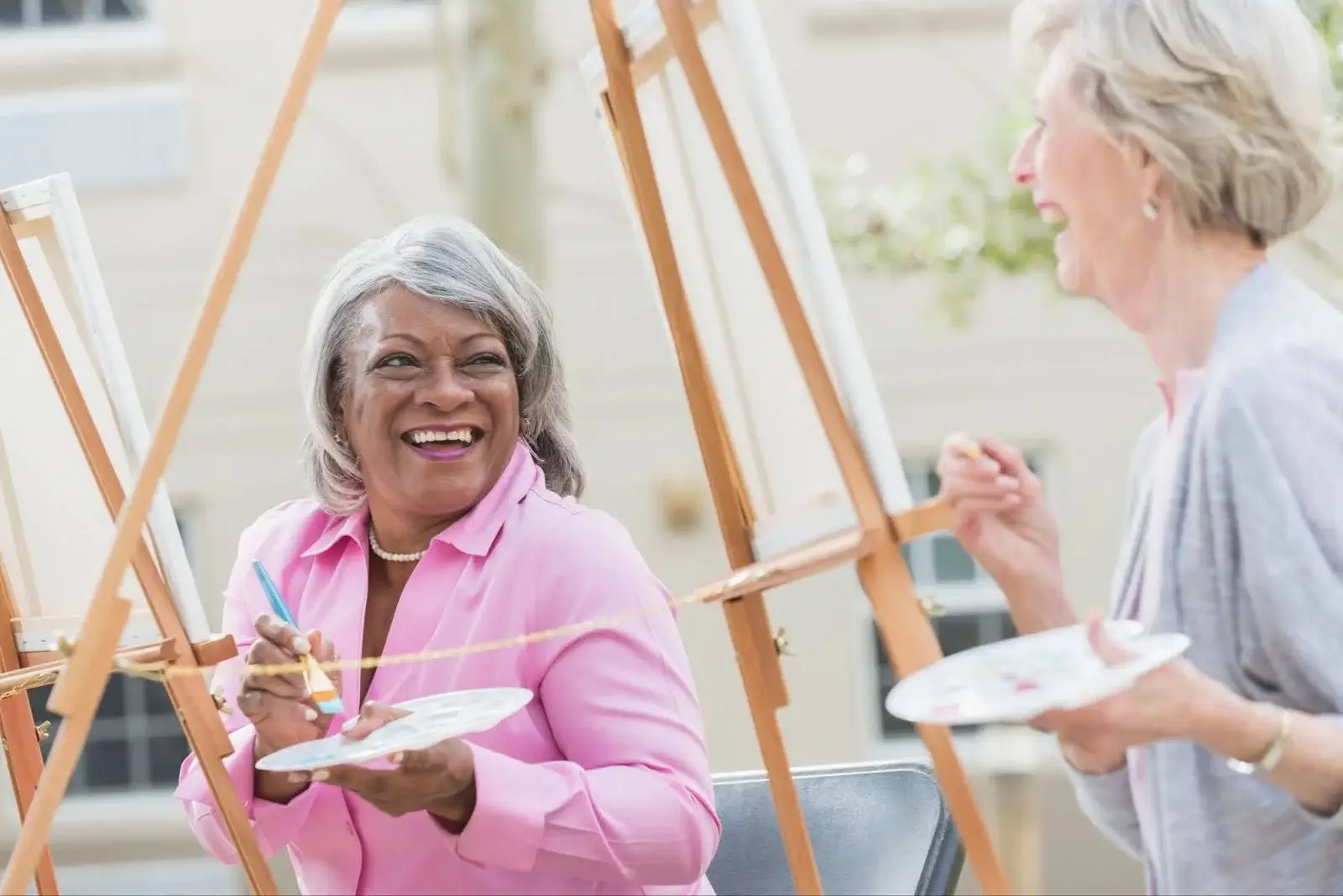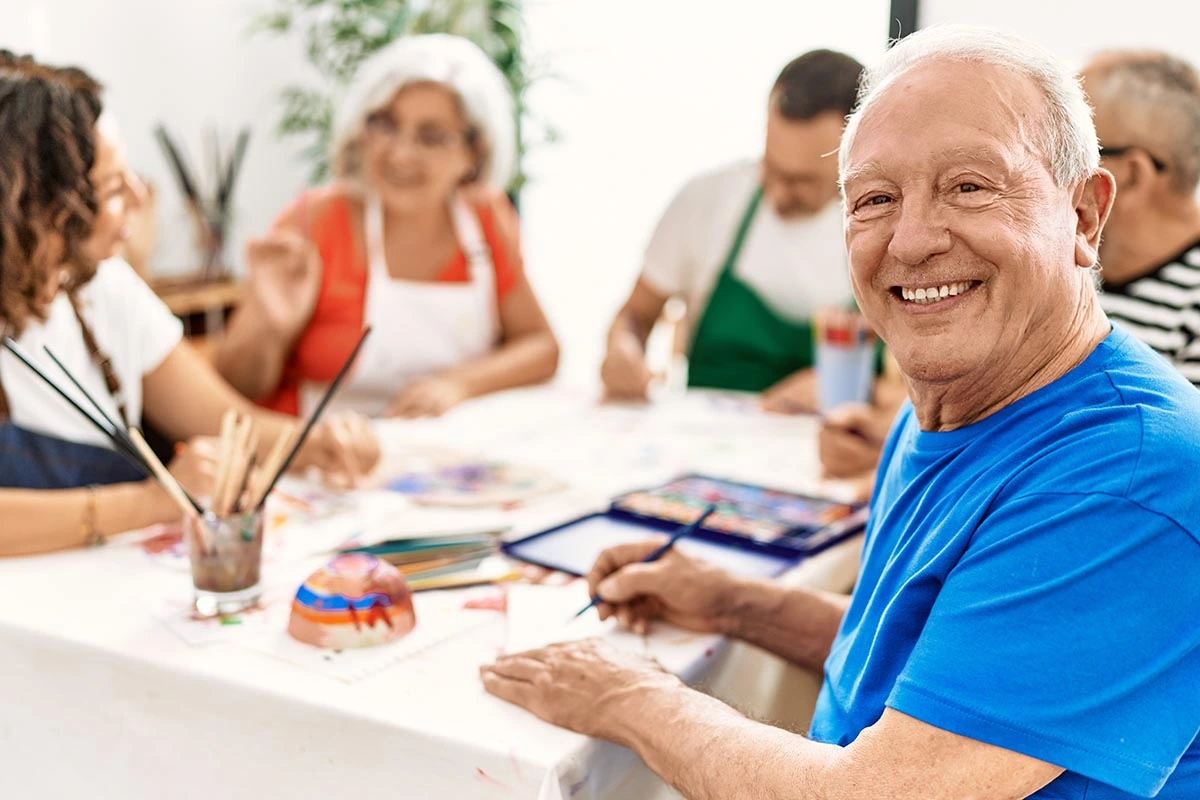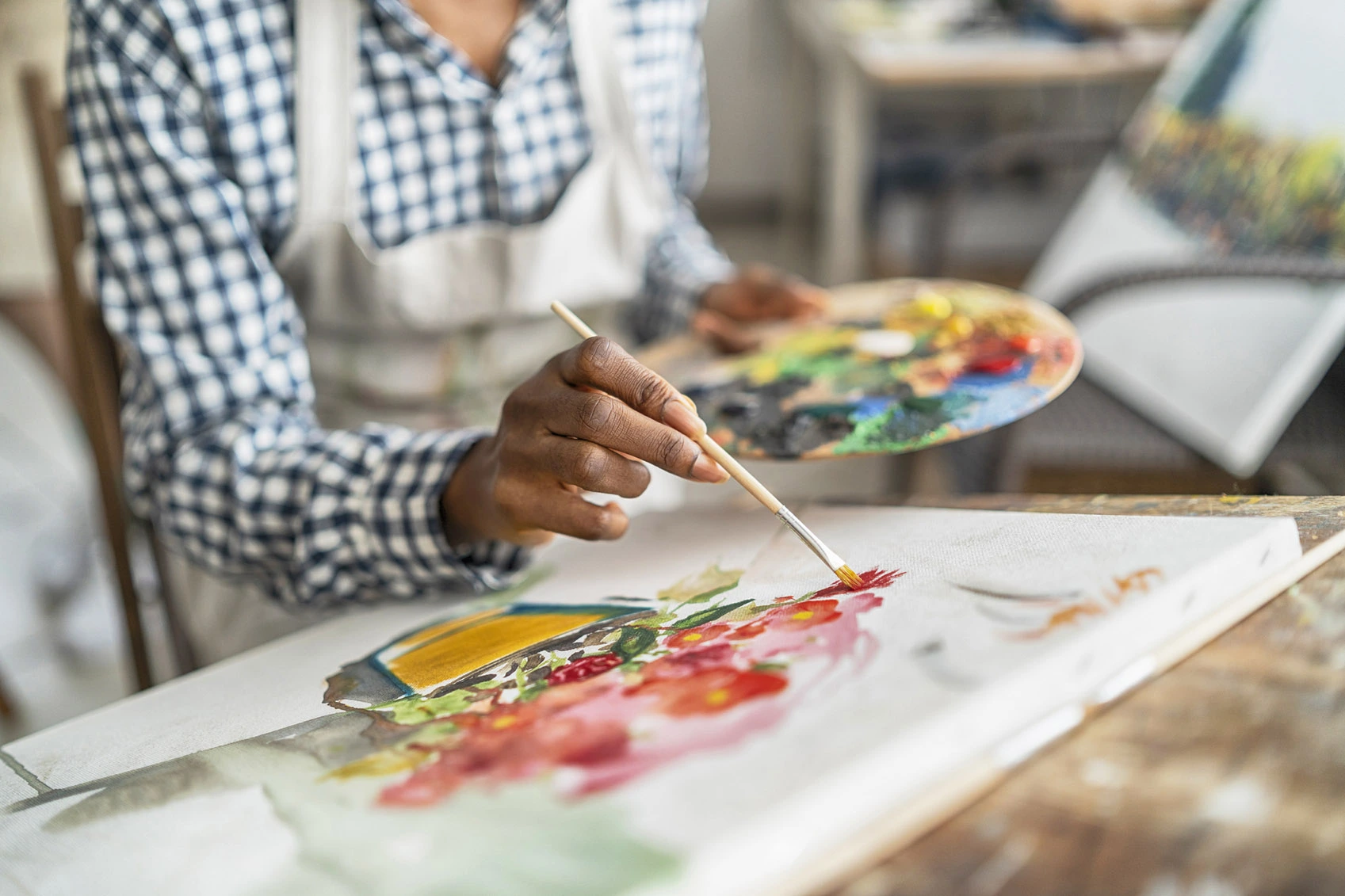
6 Proven Painting for Elderly Benefits
What are painting for elderly benefits? Did you know that painting has numerous benefits for your health and mind? As you age, it becomes more important to maintain a fit body and mental strength. Doctors recommend regular exercise to have a healthy body, but what about staying mentally sharp as seniors?
Finding a creative way to express your inner feelings can keep your mind strong and at the same time allow you to experience new ideas and goals. Painting is one of the fascinating hobbies that strengthens your mind and has numerous benefits for your health. In this article from humanhealthmag, we will highlight some proven benefits of painting for seniors that promote mental well-being and improve quality of life.
Art Therapy with Painting in the Elderly
One way to understand the emotions of the elderly is through art therapy. In fact, art therapy like music therapy for seniors helps them overcome their challenges. For example, painting is one activity that helps keep the brains of older adults active and is beneficial for seniors with Alzheimer’s disease.
One of painting for elderly benefits is that it helps stimulate their memory, thereby preventing Alzheimer’s. It assists elderly individuals who have difficulty verbally expressing their emotions to convey their feelings through painting. As a result, engaging in this activity leads to a better sense of self. Therefore, art therapy with the elderly is one of the responsibilities of a caregiver for the elderly and one of the group activities for seniors in nursing homes.
Another method of art therapy for seniors through painting is to enroll them in group painting classes. This helps them feel less lonely and isolated, allowing them to connect with their peers and enjoy socializing. In art therapy for adults, since eye-hand coordination is important, it serves as both a mental exercise and a light form of physical activity for them.
Furthermore, benefits of painting for seniors and the impact of painting on depression in the elderly is very significant. When they are engaged in painting, it prevents them from dwelling on other things, and their mental preoccupations decrease, which helps improve existing depression or prevent it from developing.

Painting for Elderly Benefits
Why is painting good for the elderly? Engaging in painting offers many benefits for seniors, extending beyond mere artistic expression. It serves as a powerful tool for maintaining cognitive function by stimulating memory and fostering creativity. Furthermore, painting provides an outlet for emotional release, reducing stress and anxiety, which are critical for overall well-being. The development of fine motor skills and problem-solving abilities through painting also contributes to a higher quality of life. In the following sections, we will delve deeper into each of these painting for elderly benefits.
| Cognitive Benefits | Physical Benefits | Emotional and Social Benefits |
| Enhanced Memory | Improved Motor Skills | Stress Relief |
| Cognitive Stimulation | Hand-Eye Coordination | Improved Mood |
| Creative Thinking | Increased Blood Flow | Social Interaction |
| Problem-solving | Self-Expression | |
| Increased Self-Esteem | ||
| Combating Loneliness |
1- The Impact of Painting on Nurturing Creativity
For individuals whose right brain hemisphere is dominant, engaging in artistic activities such as painting comes more easily. However, it should not be assumed that those with a dominant brain left hemisphere cannot do it. Among the characteristics of this group is their high ability to focus and practice, and these qualities are very important and necessary for acquiring painting skills. Thus, individuals can cultivate their creative power by using painting skills.
2- Strengthening Memory Through Painting
Painting can enhance recall skills and memory through visualizations and conceptual implementations. Research has shown that individuals who regularly engage in creative skills such as writing and painting are less likely to experience memory-related diseases as they age. Painting skills help individuals express their emotions without words. Painting is a means by which people overcome their shyness and express their personality.

3- Developing Motor Skills and Problem-Solving Abilities
Most people assume that painting for elderly benefits only enhances creativity skills, but many would be surprised to learn that it also improves critical thinking skills. An artist must possess perceptual thinking to bring several solutions to life while painting. What the artist envisions at the start of a painting can completely change due to color limitations and unexpected outcomes during the painting process.
Artistic vision evolves during the painting process, building important problem-solving skills. Thinking outside the box becomes part of a painter’s nature. In fact, a critical eye and a form of critical thinking with a very high level of understanding take shape within you through learning and practicing painting. When an individual chooses painting as a hobby, motor skills also improve. The skillful control of the brush enhances hand and finger dexterity. The motor skills developed in a painter become a mental shortcut that also improves brain function in daily life.
4- Painting for Elderly Benefits in Relieving Stress
Stress is a problem that everyone deals with to some extent. Like other art forms, painting skills alleviate stress by releasing individuals’ emotions. Focusing on painting calms the mind and diminishes the problems and needs that cause stress. Lower stress levels lead to a happier and healthier lifestyle and also help improve mental well-being.
5- Promoting an Optimistic Outlook Through Painting
Creating beautiful paintings fosters an optimistic attitude towards life. A painter sets goals to enhance their skills and become a masterful artist, and when this goal is achieved, a positive emotional response is generated. Over time, the painter’s progress reduces negative feelings and brings pleasure and contentment. Additionally, positive feedback from others regarding the individual’s achievements instills a sense of pride and life satisfaction.
6- Painting for Elderly Benefits and Its Impact on Cultivating Emotions
Painters express their emotions through their art. This allows the artist to pay close attention to their emotional state, something they might not even notice under normal circumstances. The painter, in effect, releases their emotions through this medium. Even therapists recommend painting skills as therapy for some mental health patients.

Painting, in a way, strengthens individuals’ emotional intelligence and helps them better understand their inner feelings. While painting may not directly contribute much to our physical fitness, overall painting for elderly benefits is undeniable. Clearly, engaging in painting as a hobby promotes mental well-being at all ages. This branch of art not only induces a sense of joy in the artist but also in those around them.
Painting for Elderly Benefits on Alzheimer’s and Dementia
As you know, there is still no definitive cure for Alzheimer’s and dementia, but art therapy can help delay the progression of these diseases in the elderly. One of the problems these patients struggle with is the presence of stress and anxiety.
One of the benefits of painting for seniors with dementia is that it helps reduce this stress and anxiety. Additionally, these art form stimulate the brain and may even help them recall past memories. These individuals have difficulty interacting with people in social settings and cannot communicate well. Art therapy and dementia friendly easy coloring pages for dementia patients helps address this issue by holding group sessions.
Painting for Elderly Benefits on Memory Enhancement
One of the most significant benefits of art and painting for older adults is the stimulation of long-term and short-term memory. Furthermore, by stimulating memory, art therapy helps them increase their focus and attention on tasks. Participating in art therapy activities requires individuals to concentrate on a specific activity and perform it with high precision, which impacts memory enhancement.
Stress and anxiety are considered memory killers and have negative effects on individuals’ memory, but art therapy, by reducing stress and anxiety, prevents memory problems and even strengthens memory.

Concluding Remarks
In this article from Humanhealthmag, we discussed painting for elderly benefits and stated that painting can have many benefits for everyone, especially the elderly. They can express their feelings and emotions through painting and use art to express their feelings instead of words. Also, art therapy has other benefits and advantages; for example, it helps improve memory function in people with dementia and Alzheimer’s.
We’ve shared our thoughts and now it’s YOUR turn! Please share your insights in the comments, and let’s start a meaningful discussion that will help others, too! If you know any other tips about the effect of art therapy on the elderly, share them with us and the site users.
Frequently Asked Questions
How does art therapy help seniors express their emotions?
Art therapy assists seniors in expressing their feelings and emotions non-verbally. Through painting, sculpting, and other art forms, older adults can visually represent their inner feelings, leading to a better understanding of themselves.
How can painting help improve memory function in seniors?
Painting helps seniors enhance their focus and attention by stimulating both long-term and short-term memory. Engaging in artistic activities requires high concentration, which aids in memory strengthening. Additionally, the reduction of stress and anxiety through art therapy also contributes to improved memory.
What art forms can be beneficial in art therapy for seniors?
Art forms such as painting, sculpting, crafting, knitting, jewelry making, music, and writing can be beneficial in art therapy for seniors. Each of these art forms helps older adults express their emotions and strengthen various skills.
How can painting help reduce stress and anxiety in seniors?
Painting helps seniors reduce their stress and anxiety by providing opportunities to express their feelings and emotions. Engaging in artistic activities creates a sense of calm and satisfaction in older adults, thereby helping to lower stress and anxiety levels.
How can art therapy help improve the social skills of seniors?
Participating in group art classes, such as painting and sculpting, helps seniors connect with their peers and engage in discussions and exchanges of ideas. These social interactions enhance the social skills of older adults and prevent loneliness and isolation.
